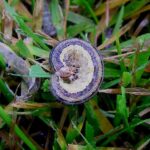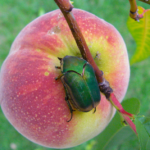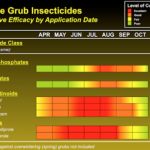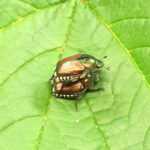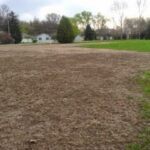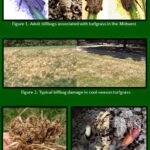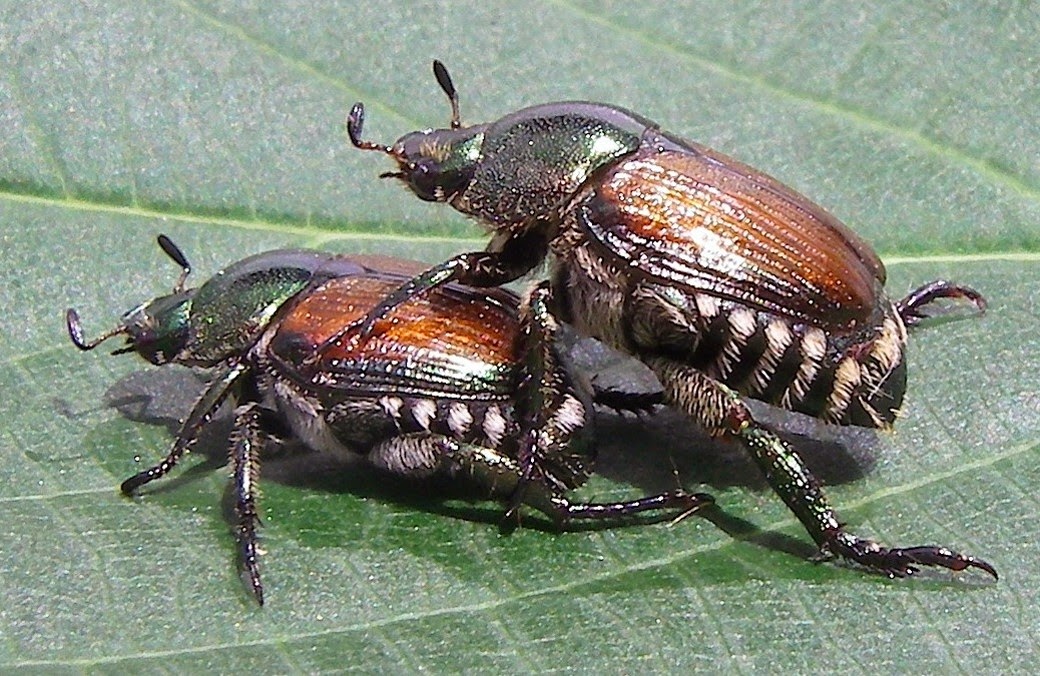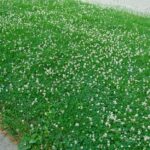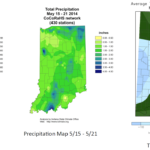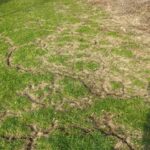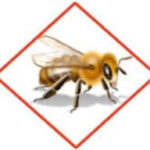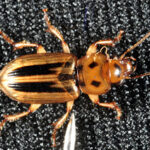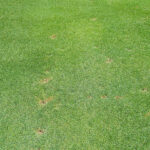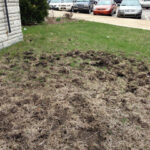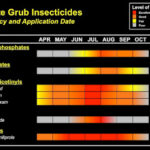Category: Pest Control
Monitoring and Managing Caterpillars
Doug Richmond Associate Professor and Entomology Extension Specialist Department of Entomology Purdue University Caterpillars are the larvae of moths and butterflies and several common species are capable of damaging turfgrass. This publication will help you detect and identify the most common caterpillars associated with turfgrass. Armyworms Armyworms are the immature stage (larva/caterpillar) of the several […]
What Was That? Flying Green June Beetles Will Get Your Attention
Green June beetles Cotinus nitida have been flying in many areas across the Midwest and although they are harmless, their sheer size can be very intimidating to folks who don’t recognize them. These large, attractive, emerald and copper colored beetles (Fig. 1) are one of several species of scarab beetles whose larvae are known as […]
White Grub Season is Here
This is the time of year when annual white grubs begin to infest turfgrass and, in the Midwest, we are blessed with an assortment of different annual white grub species. This group of insects produces one generation each year with the adults becoming active by early June. Adults lay eggs in turf and 1st instar […]
Japanese Beetle Adults Emerging
We’ve been seeing a smattering of Japanese beetle adults in our traps for the last few weeks in West Lafayette, but it appears their numbers are starting to increase as we head toward the end of June. Expect to see emergence come into full swing over the next two weeks in this part of the […]
European Chafer Causing Serious Damage in Northeastern Indiana
Although reports of spring white grub damage have been relatively uncommon in Indiana in recent years, there have been a growing number of cases in the northeastern part of the state. The European chafer Rhizotrogus majalis Razoumowsky is apparently at the root of several reports of large scale and severe damage to turfgrass this spring. […]
Hunting Billbug Larvae Overwintering in Indiana
We recently discovered that the hunting billbug is capable of successfully overwintering in the larval stage as far north as West Lafayette Indiana. This insect is mainly a pest of warm-season turfgrasses such as Bermudagrass and zoysiagrass and has become a perennial problem in parts of the state where these grasses are cultured. Although we’ve […]
Armyworms Invade Indiana
There appears to be a wide-spread outbreak of armyworms [Pseudaletia (=Mythimna) unipuncta (Haworth)] infesting residential turf across southern Indiana. These insects typically have 2 generations per year in this part of the country and we are in the midst of the 2nd generation of larvae. Adult armyworm moths lay their eggs in large masses and […]
Billbugs Are Here!
Here we are in the second week of July – a time when conditions start to become difficult for cool-season grasses. Heat, drought and wear during this time of the season may all contribute to declining turfgrass quality. However, one of the most commonly overlooked reasons for declining turfgrass quality during this difficult time of […]
Japanese Beetles are Upon Us
The first Japanese beetles of the year were captured June 8 in West Lafayette. Emergence is now in full swing. This imported pest is common east of the Mississippi river and in the Mississippi river valley. Adults feed on more than 400 plant species including many common ornamental plants. The soil-dwelling larvae (grubs) feed on […]
European Chafer is at the Root of Spring Grub Damage in Northern Indiana
Reports of spring white grub damage are relatively uncommon in most of the Midwest. However, the European chafer is a slightly different beast and seems to be more cold-hardy than other annual white grubs. This characteristic allows it to feed later into the fall and start feeding earlier in the spring compared to Japanese beetle […]
Weed Management is a Prerequisite for Using Neonicotinoid Insecticides
Honey bees and other pollinators forage for nectar and pollen on a wide range of flowering plants, including some of our most common turfgrass weeds such as dandelion, white clover, ground ivy, speedwell, chickweed and a host of others. If any of these flowering weeds are present at noticeable levels, it may be wise to […]
Early Season Caterpillar Update
Most of Indiana experienced cooler than normal temperatures over the last week, with good amounts of precipitation providing very good growing conditions for cool-‐season turf. However, green-‐up of warm-‐season grasses has been slow, so we have a relatively mixed bag for insect development and damage. The cooler temperatures and ample rainfall should help mask insect […]
Melting Snow Reveals Tiny Trails
With the winter snows finally melting away many are often surprised to find a series of tiny trails on the surface of their lawns and turfgrass fields. These are vole highways. Voles are often called meadow or field mice. While they are similar to a house mouse in general size and shape, they […]
New Insecticide Labels to Increase Focus on Pollinator Protection
As part of an ongoing effort to raise consciousness about the potential threat to pollinators posed by neonicotinoid insecticides, the USEPA recently unveiled new pesticide labeling criteria.The new labels will contain a bee advisory box and icon with information on routes of exposure and spray drift precautions. http://yosemite.epa.gov/opa/admpress.nsf/0/C186766DF22B37D485257BC8005B0E64 The recent announcement focuses on products […]
White Grub Season Approaching: Remember to Follow Label Directions
Last month, a commercial landscape manager in Oregon made an off label application of dinotefuran to flowering linden trees resulting in the death of more than 25,000 bumblebees and immediate action by the Oregon Department of Agriculture to implement a six month ban on all dinotefuran products labeled for landscape use http://www.oregon.gov/ODA/docs/pdf/news/130627dinotefuran.pdf The labels […]
Seed corn beetle being reported by superintendents
In addition to earthworms, there are several insects that can create small mounds of soil above the surface of turfgrass. Occasionally, the mounds can become a nuisance, especially on closely mowed greens where they are more noticeable and may interfere with play. The photos below depict one such insect, the seed corn beetle, and the […]
Caterpillar Update
Although they are fairly easy to control, caterpillars like cutworms and armyworms can have a way of “sneaking” up on turf managers. For golf course superintendents, we’ve reached that point in the spring when black cutworms may be large enough to cause visible damage (»300 Degree Days). Unless you have a preventive program in place, […]
Guess Who Came to Dinner?
The photos below were submitted to our laboratory for identification. While there are no animals present in the photos, the damage depicts the problem very nicely. Even without seeing any, I am quite certain that the turf is infested with white grubs. As you know, white grubs do some damage to grasses, but what […]
Japanese Beetle Emergence Begins
We captured the first Japanese beetle adults of the year last week in our traps on the Purdue Campus. These traps are located in an area where emergence tends to take place much earlier than at most locations, so don’t expect to see any significant wide-scale emergence for another 2-3 weeks. We monitor this particular […]
